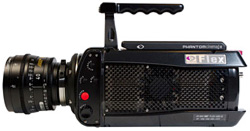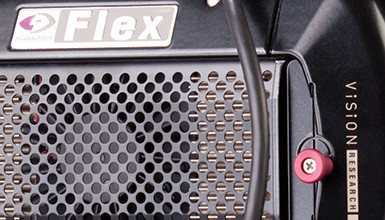In the interview, Moe discusses the new features and technical breakthroughs that bring the Phantom Flex to a new level.

Q: Phantom cameras are known for their outstanding image quality and breathtaking slow motion imagery. What makes the Phantom Flex new and unique?
A: Sensitivity, frame rate, ease of use and quality make the new Phantom Flex a most unique digital camera. The 1,000 ISO rating opens new opportunities for shooting high-speed in lower light. Frame rate depends on the chosen resolution and is faster than ever with the Flex. At 1920x1080 the Flex is capable of over 2,500 frames per second, or over 5,000 fps at 720P. A new HQ mode makes the camera easier to use, as it does not require black balance to be done by the operator. This also improves dynamic range. Video quality is improved through an oversampling technique, where the full 1.78 resolution of the sensor (2560x1440) is scaled to standard 1920x1080 or 1280x720 output at 4:4:4 or 4:2:2. There are other new features, but those are the major ones.
Q: How is the Phantom Flex operated? Is it necessary to use a computer?
A: New on-board controls and an improved user interface allow the Phantom Flex to be controlled during production without the need for a computer. A laptop is only needed for software updates and initial setup in prep. A new remote controller from Vision Research (RCU) and a new controller from Abel Cine Tech (PCU) provide more options for controlling all camera parameters without the need for a computer.
Q: Are there any tradeoffs in using the HQ mode you mentioned?
A: The new HQ mode improves dynamic range and eliminates the need for black balance by essentially doing a black balance automatically every frame. The exact technique for doing this is a proprietary secret of Vision Research, but it uses a "frame worth" of space next to every "taking frame" to do its magic. The resulting trade off is a reduction by half of the maximum frame rate. Thus, while the maximum frame rate at 1920x1080 is 2,570 in SQ mode, the corresponding max frame rate in HQ mode is half that at 1,285.
Q: Can you describe the automatic scaling feature in more detail?
A: Automatic scaling is an option for those shooting with PL lenses who wish to take advantage of the full sensor resolution. By oversampling at 2560x1440 and scaling to 1920x1080, video output directly from the camera is improved. The scaling can also take place at a later stage if using the CineStation. The raw data is flagged to indicate that the full size of the sensor was intended for framing purposes.
Q: What lenses can be used on the Phantom Flex?
A: A variety of lens options contributed to the Flex name. PL mount lenses can be used with Automatic Scaling, as described, or a 1920x1080 extraction can be pulled from the full sensor. B4 mount 2/3" lenses can be used in conjunction with the new HDx2 optical adapter from Abel Cine Tech, which converts the smaller diagonal target area of these lenses to exact diagonal dimension of 1920x1080 on the Phantom Flex sensor. Super16 lenses fit onto the Flex and cover 1280x720 without the need for an adapter.
Q: Are there any other new features of the Phantom Flex we should mention?
A: Yes, there are several. The overall camera is smaller and lighter than previous Phantoms. A capping shutter makes black balancing much easier when shooting in SQ mode. The on-board controls are redesigned and located in a more convenient place. SMPTE timecode can be integrated with the camera???s military grade IRIG timecode. Two 24-volt power inputs allow for hot-swapping of batteries, and there is 12V accessory power directly from the camera.
Q: What's new in CineMags?
A: The new CineMag II is smaller, lighter and available in 3 capacities - 512GB, 256GB and the new 128GB. Older CineMag I models work on the Phantom Flex and on all CineStations as well. All CineMags are hot-swappable and use non-volatile memory. You can record up to 450fps directly onto a CineMag (at 1920x1080) or upload from camera RAM for higher frame rates.
Q: Are there other new accessories available with the Phantom Flex?
A: A new riser plate from Abel Cine Tech, specifically designed for the Flex, receives 15mm iris rods along with a new magnetic mount for a shoulder pad. The new HDx2 optical adapter for B4 mount lenses works with the Flex, as previously mentioned; and a new 12v battery holder and 12v power converter will be coming soon from Abel.
Q: When will the Phantom Flex be available, and where can I get one?
A: The first Phantom Flex cameras began shipping to US rental houses at the beginning of September 2010. Early prototypes were available during the summer for demonstration and testing, and these cameras performed very well. The cameras now shipping have all major features implemented.
New cameras can be purchased in North America from Abel Cine Tech.
















